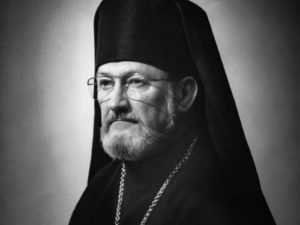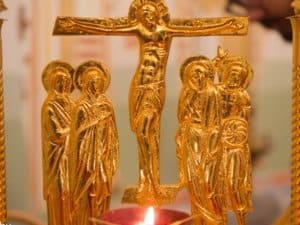CHICAGO, IL [DOM] – April 11 commemorates the falling asleep of His Eminence Archbishop John (Garkalvas). The Archbishop served the Diocese of the Midwest from 1957-1978, and is remembered for many of his great attributes, but also for his guardianship of the Tikhvin Icon of the Mother of God. The late Archbishop will be remember at the Diocesan Cathedral this evening and throughout the diocese.
John Garklavs was born in Limbashi, Latvia in 1899. In order to know something about a person, one should search for some of the influences on his formative years: a brief sketch of dates and places is insufficient to learn what motivates a man to think and accomplish what he does. Who was it that molded Archbishop JOHN’s life and ideals?
 The French have a saying: Look for the woman. Actually, there were two women who influenced the development of the Archbishop. One was the Most Holy Theotokos. For many, many years, he was the guardian of the miracle-working icon: Our Lady of Tikhvin. Who would not be able to recall the joy and adoration in the face of the Archbishop as he presented this icon to the faithful of the Church, whether in his own diocese, or in other parishes throughout the country?
The French have a saying: Look for the woman. Actually, there were two women who influenced the development of the Archbishop. One was the Most Holy Theotokos. For many, many years, he was the guardian of the miracle-working icon: Our Lady of Tikhvin. Who would not be able to recall the joy and adoration in the face of the Archbishop as he presented this icon to the faithful of the Church, whether in his own diocese, or in other parishes throughout the country?
The other woman was his mother, who indeed was a special woman. She was left a widow with two infant sons: a baby six months of age; and the older, John, merely two years old. They lived in the small provincial town of Limbashi, Latvia, located about eighty miles from Riga. It was in that small town that the young John spent his early childhood, completing the primary schools, while taking an active part in the Latvian Orthodox Church, first as an altar boy, later becoming a psalomchik. After graduating from seminary, the young man was chosen as the choirmaster of his local parish.
His mother was a gifted singer, being a lead alto in many European choirs. A strong voice, with the desire to use it in praise of Almighty God, was her legacy to the Archbishop.
 Vladiko’s mother never remarried following the death of her husband, but continually cared for her two sons. Once, many years before his ordination, she saw in a dream her son John being dressed in white bishop’s vestments in the center of the church. The dream came to her once more, giving her a premonition that he would serve as a bishop in two hemispheres. She did live to see him ordained to the Holy Priesthood in 1936, and consecrated a bishop in 1943. Archbishop John brought his mother with him to the United States in 1949. She survied in America for only eight months, and was laid to rest in the cemetery at St. Tikhon’s Monastery, South Canaan, PA.
Vladiko’s mother never remarried following the death of her husband, but continually cared for her two sons. Once, many years before his ordination, she saw in a dream her son John being dressed in white bishop’s vestments in the center of the church. The dream came to her once more, giving her a premonition that he would serve as a bishop in two hemispheres. She did live to see him ordained to the Holy Priesthood in 1936, and consecrated a bishop in 1943. Archbishop John brought his mother with him to the United States in 1949. She survied in America for only eight months, and was laid to rest in the cemetery at St. Tikhon’s Monastery, South Canaan, PA.
In 1943, when the Archbishop was consecrated, churches were caught up assisting the unfortunate masses displaced by World War II, helping to provide aid, care, medical assistance, food, etc. Priests and their families from Eastern Europe would occupy Vladiko’s apartment for weeks at a time until they could be assigned parishes. Eventually, the Archbishop would become a refugee himself.
Leaving Riga with a small colony of Latvian Orthodox priests, and a newly adopted son, Sergei, Archbishop John took refuge in southern Czechoslovakia until the War’s end. Moving his small spiritual colony to West Germany, then being held by American troops, he encouraged Orthodox Christians there to organize parishes and build chapels in the towns and camps set up for “Displaced Persons,” and spent much time traveling among the people.
In 1949, Archbishop John immigrated to the United States, when in 1957 he was elected as bishop of the Chicago-Minneapolis Diocese, serving until his retirement.
He fell asleep in the Lord on April 11, 1982, the feast of the Triumphal entry of our Lord Jesus Christ into Jerusalem.



